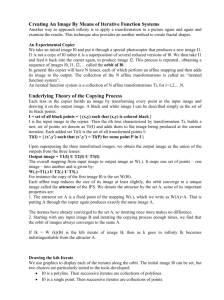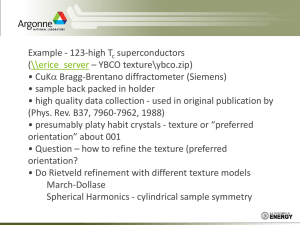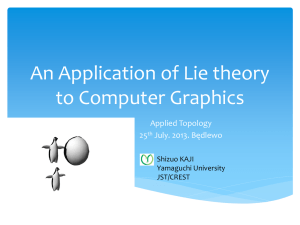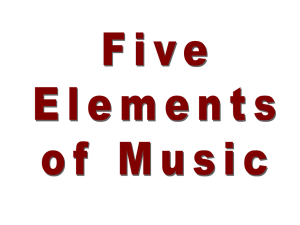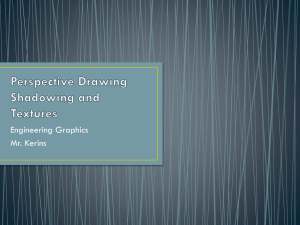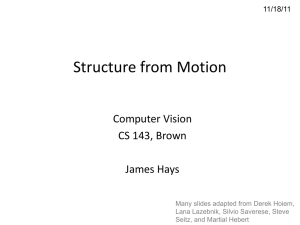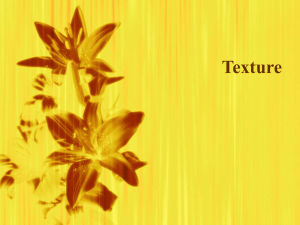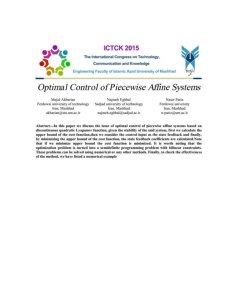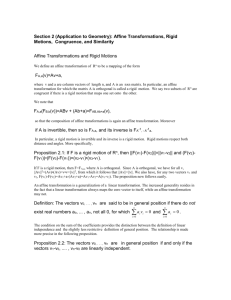PowerPoint - University of Illinois at Urbana
advertisement
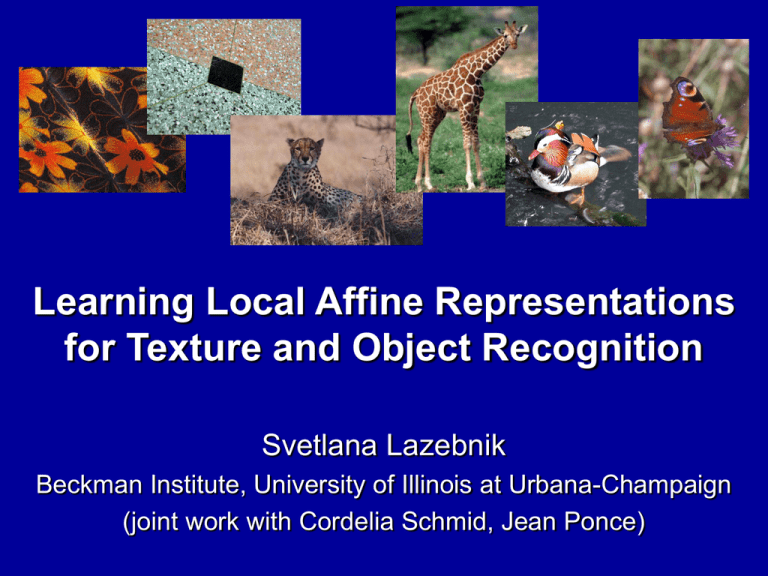
Learning Local Affine Representations
for Texture and Object Recognition
Svetlana Lazebnik
Beckman Institute, University of Illinois at Urbana-Champaign
(joint work with Cordelia Schmid, Jean Ponce)
Overview
• Goal:
– Recognition of 3D textured surfaces, object classes
• Our contribution:
– Texture and object representations based on
local affine regions
• Advantages of proposed approach:
– Distinctive, repeatable primitives
– Robustness to clutter and occlusion
– Ability to approximate 3D geometric transformations
The Scope
1. Recognition of single-texture images (CVPR 2003)
2. Recognition of individual texture regions in multi-texture
images (ICCV 2003)
3. Recognition of object classes (BMVC 2004, work in progress)
1. Recognition of Single-Texture Images
Affine Region Detectors
Harris detector (H)
Laplacian detector (L)
Mikolajczyk & Schmid (2002), Gårding & Lindeberg (1996)
Affine Rectification Process
Patch 1
Patch 2
Rectified patches (rotational ambiguity)
Rotation-Invariant Descriptors 1:
Spin Images
• Based on range spin images (Johnson & Hebert 1998)
• Two-dimensional histogram:
distance from center × intensity value
Rotation-Invariant Descriptors 2: RIFT
• Based on SIFT (Lowe 1999)
• Two-dimensional histogram:
distance from center × gradient orientation
• Gradient orientation is measured w.r.t. to the direction pointing
from the center of the patch
Signatures and EMD
• Signatures
S = {(m , w ), … , (m , w )}
1
1
k
k
mi — cluster center
wi — relative weight
• Earth Mover’s Distance (Rubner et al. 1998)
– Computed from ground distances d(mi, m'j)
– Can compare signatures of different sizes
– Insensitive to the number of clusters
Database: Textured Surfaces
25 textures, 40 sample images each (640x480)
Evaluation
• Channels: HS, HR, LS, LR
– Combined through addition of EMD matrices
• Classification results
– 10 training images per class, rates averaged over
200 random training subsets
Comparative Evaluation
Our method
Varma & Zisserman
(2003)
Spatial selection
Harris and Laplacian
detectors
None (every pixel
location is used)
Neighborhood shape
selection
Affine adaptation
None (support of
descriptors is fixed)
Descriptors
Spin images, RIFT
Raw pixel values
Textons
Separate set of textons
for each image
Universal texton
dictionary
Representing/comparing Signatures/EMD
texton distributions
Histograms/
chi-squared distance
Results of Evaluation:
Classification rate vs. number of training samples
(H+L)(S+R)
VZ-Joint
VZ-MRF
• Conclusion: an intrinsically invariant representation is
necessary to deal with intra-class variations when they are
not adequately represented in the training set
Summary
• A sparse texture representation based on local affine
regions
• Two novel descriptors (spin images, RIFT)
• Successful recognition in the presence of viewpoint
changes, non-rigidity, non-homogeneity
• A flexible approach to invariance
2. Recognition of Individual Regions in
Multi-Texture Images
• A two-layer architecture:
– Local appearance + neighborhood relations
• Learning:
– Represent the local appearance of each texture class
using a mixture-of-Gaussians model
– Compute co-occurrence statistics of sub-class labels over
affinely adapted neighborhoods
• Recognition:
– Obtain initial class membership probabilities from the
generative model
– Use relaxation to refine these probabilities
Two Learning Scenarios
• Fully supervised: every region in the training image
is labeled with its texture class
brick
• Weakly supervised: each training image is labeled
with the classes occurring in it
brick, marble, carpet
Neighborhood Statistics
Estimate:
• probability p(c,c')
• correlation r(c,c')
Neighborhood definition
Relaxation (Rosenfeld et al. 1976)
• Iterative process:
– Initialized with posterior probabilities p(c|xi) obtained from
the generative model
– For each region i and each sub-class label c, update the
probability pi(c) based on neighbor probabilities pj(c') and
correlations r(c,c')
• Shortcomings:
– No formal guarantee of convergence
– After the initialization, the updates to the probability values
do not depend on the image data
Experiment 1: 3D Textured Surfaces
Single-texture images
T1 (brick)
T2 (carpet)
T3 (chair)
T4 (floor 1)
T5 (floor 2)
T6 (marble)
T7 (wood)
Multi-texture images
10 single-texture training images per class, 13 two-texture training images, 45 multi-texture test images
Effect of Relaxation on Labeling
Original image
Top: before relaxation, bottom: after relaxation
Retrieval
(single-texture training images)
T1 (brick)
T2 (carpet)
T5 (floor 2)
T3 (chair)
T6 (marble)
T4 (floor 1)
T7 (wood)
Successful Segmentation Examples
Unsuccessful Segmentation Examples
Experiment 2: Animals
cheetah, background
zebra, background
giraffe, background
• No manual segmentation
• Training data: 10 sample images per class
• Test data: 20 samples per class + 20 negative
images
Cheetah Results
Zebra Results
Giraffe Results
Summary
• A two-level representation (local appearance +
neighborhood relations)
• Weakly supervised learning of texture models
Future Work
• Design an improved representation using a random
field framework, e.g., conditional random fields
(Lafferty 2001, Kumar & Hebert 2003)
• Develop a procedure for weakly supervised
learning of random field parameters
• Apply method to recognition of natural
texture categories
3. Recognition of Object Classes
The approach:
• Represent objects using multiple composite
semi-local affine parts
– More expressive than individual regions
– Not globally rigid
• Correspondence search is key to learning and
detection
Correspondence Search
• Basic operation: a two-image matching procedure for finding
collections of affine regions that can be mapped onto each
other using a single affine transformation
A
• Implementation: greedy search based on geometric and
photometric consistency constraints
– Returns multiple correspondence hypotheses
– Automatically determines number of regions in correspondence
– Works on unsegmented, cluttered images (weakly supervised learning)
Matching: 3D Objects
Matching: 3D Objects
closeup
closeup
Matching: Faces
spurious match ???
Finding Symmetries
Finding Repeated Patterns and
Symmetries
Learning Object Models for Recognition
• Match multiple pairs of training images to produce a
set of candidate parts
• Use additional validation images to evaluate
repeatability of parts and individual regions
• Retain a fixed number of parts having the best
repeatability score
Recognition Experiment: Butterflies
Admiral
•
•
•
•
Swallowtail
Machaon
Monarch 1
Monarch 2
16 training images (8 pairs) per class
10 validation images per class
437 test images
619 images total
Peacock
Zebra
Butterfly Parts
Recognition
• Top 10 parts per class used for recognition
total number of regions detected
• Relative repeatability score:
total part size
• Classification results:
Total part size (smallest/largest)
Classification Rate vs.
Number of Parts
Detection Results (ROC Curves)
Circles: reference relative repeatability rates. Red square: ROC equal error rate (in parentheses)
Successful Detection Examples
Training images
Test images (blue: occluded regions)
All ellipses found in the test images
Unsuccessful Detection Examples
Training images
Test images (blue: occluded regions)
All ellipses found in the test image
Summary
• Semi-local affine parts for describing structure
of 3D objects
• Finding a part vocabulary:
– Correspondence search between pairs of images
– Validation
• Additional application:
– Finding symmetry and repetition
Future Work
• Find a better affine region detector
• Represent, learn inter-part relations
• Evaluation: CalTech database, harder classes, etc.
Birds
Egret
Snowy Owl
Mandarin Duck
Puffin
Wood Duck
Birds: Candidate Parts
Mandarin Duck
Puffin
Objects without Characteristic Texture
(LeCun’04)
Summary of Talk
1. Recognition of single-texture images
•
Distribution of local appearance descriptors
2. Recognition of individual regions in
multi-texture images
•
Local appearance + loose statistical neighborhood
relations
3. Recognition of object categories
•
Local appearance + strong geometric relations
For more information:
http://www-cvr.ai.uiuc.edu/ponce_grp
Issues, Extensions
• Weakly supervised learning
– Evaluation methods?
– Learning from contaminated data?
•
•
•
•
•
Probabilistic vs. geometric approaches to invariance
EM vs. direct correspondence search
Training set size
Background modeling
Strengthening the representation
– Heterogeneous local features
– Automatic feature selection
– Inter-part relations
